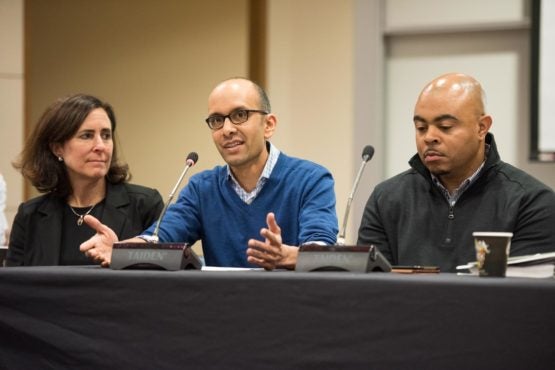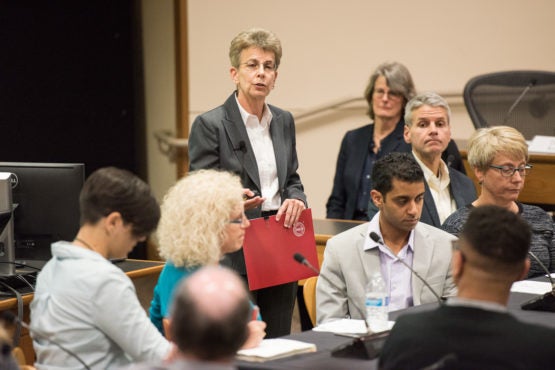Faculty Senate hears reports on long-range planning efforts, postdoctoral scholars
At its Nov. 30 meeting, the Senate also heard an update from President Marc Tessier-Lavigne on advocacy efforts regarding federal tax proposals.
At the Faculty Senate meeting on Thursday, co-chairs of the area steering groups gave an update on the long-range planning process and provided insights into how they reviewed and analyzed the more than 2,800 proposals that came in from across the campus community and from alumni.
The senate also heard a report on Stanford’s support for its growing population of postdoctoral scholars. Presenters outlined some of the challenges the scholars face and offered recommendations for strengthening the postdoctoral experience.
In addition, President Marc Tessier-Lavigne gave an update on advocacy efforts regarding federal tax proposals currently before Congress. The senate also adopted a resolution recognizing the contributions of the Muwekma Ohlone Tribe.
Progress on long-range planning
The four area steering groups – focused on the areas of Education, Research, Our Community and Engagement Beyond Our University – were charged with reviewing more than 2,800 ideas and proposals for Stanford’s future that came in from members of the university community earlier this year. The steering groups are composed of more than 100 faculty, students, postdoctoral scholars and staff.
“Our assignments were to categorize, organize, analyze and contextualize the different proposals,” said Sue McConnell, professor of biology and co-chair of the Our Community group. “This was, as you can imagine, quite an enormous undertaking. But I also want to emphasize something that we did not do, and that was choose winners and losers.”

A panel including, from left, Stacey Bent, Ramesh Johari and Bryan Brown presents a report from the long-range planning area steering groups at the Faculty Senate meeting on Thursday. (Image credit: L.A. Cicero)
Instead, the groups have produced 37 white papers summarizing and framing the proposals. Those papers and all of the underlying ideas and proposals are now getting an initial review from the university’s Executive Cabinet. In early February the white papers will be made available to the Stanford community for additional review and input.
McConnell said 60 percent of the submissions went to more than one steering group, reflecting the cross-cutting nature of many of the ideas. Among the prominent themes of the submissions reviewed by all groups were diversity and inclusion, the core principles of a liberal education and sustainability, McConnell said. In fact, she said, all four steering groups collaborated to produce a single white paper on the subject of sustainability.
The co-chairs said their groups went about their work in different ways, tagging proposals by subject, applying a variety of data analysis techniques, identifying common themes and creating graphic representations of them. Among the highlights:
- The Research group reviewed a wide variety of proposals on “what” topics of research Stanford should be pursuing, said Rob MacCoun, co-chair and professor of law. But there were also many “who” and “how” proposals – who does research and how their careers can be fostered, and how research activities might be organized in new ways, through new models of pop-up centers or virtual centers, or through taking advantage of shared facilities, data and resources. One common theme across many proposals, MacCoun said, was “a sense that we could be doing more to influence public policy with the research and scholarship we do, and that more people should play more of an active role in that.”
- In the Education group, major themes included modernizing educational techniques and technologies, addressing resource and facilities needs, rethinking the curriculum and its delivery, and “a call for rethinking the audience – who should be served by a Stanford education and who should provide that education,” said Bryan Brown, co-chair and associate professor of education. The proposals “really challenged us to think differently about every aspect of the infrastructure of education,” Brown said.
- The Our Community group reviewed many proposals around diversity and inclusion, the nature of the university in a time of social change, affordability, mental health and wellness, the decentralization of the campus, and the status of groups including staff, lecturers and postdoctoral scholars, according to Ramesh Johari, co-chair of the group and associate professor of management science and engineering. “Constituents were definitely heartened to see that the administration wanted to hear their ideas before developing a vision,” Johari said. “As we embark on the next phase of the process, I think there’s great anticipation in the community – many people are asking themselves how the university will continue to productively engage the community in the months and years to come.”
- The Engagement Beyond Our University group received “vastly divergent inputs,” said co-chair Juliet Brodie, associate dean for clinical education at Stanford Law School. There were ideas such as opening a Stanford campus in Bangalore, doubling the size of the undergraduate class, solving the affordability crisis in the Bay Area and ending world disease, she said. Many proposals were truly externally facing, suggesting expanded service opportunities or online education offerings, Brodie said. But hundreds of proposals were about issues that seemed to be internal yet were directed to the “beyond Stanford” group – such as affordability, sustainability and inclusion. The group concluded, she said, that “Stanford, as the global leader that it is, is sort of intrinsically engaged beyond Stanford. When Stanford acts, people watch.”
The Faculty Senate will discuss the white papers and have a further discussion of the long-range planning process at its Feb. 22, 2018, meeting.
“This is really the start, not the end, of long-range planning,” McConnell said. “The Cabinet is going to formulate a very high-level version of the future, but then all of us are going to need to be engaged in figuring out the specifics.”
Report on postdoctoral scholars
In keeping with a national trend, the number of postdoctoral scholars at Stanford has increased rapidly in the last 15 years, from 1,338 in 2002 to 2,312 currently, with the majority of scholars affiliated with the schools of Medicine (1,364) and Engineering (362).

Patti Gumport, vice provost for graduate education, standing, introduces the report on postdoctoral affairs to the Faculty Senate. (Image credit: L.A. Cicero)
Vice Provost for Graduate Education Patricia Gumport said postdoctoral training is increasingly expected and often required for more disciplines in academia, and postdoctoral scholars are integral to the academic mission of the university.
Postdoctoral scholars come to Stanford from all over the world and provide significant support to the academic enterprise at Stanford, said Anand Rao, chair of the Stanford University Postdoctoral Association. He referred to the scholars’ “invaluable” work mentoring and teaching students, contributing to grant proposals and performing a range of important administrative functions related to managing research projects.
The high cost of living in the area poses significant challenges for postdoctoral scholars at Stanford, several presenters agreed. A pilot hardship fund program was launched in 2015 and, although nearly 300 awards were made, the program fell short of meeting all the requests. Child and elder care, rent increases, relocation expenses and allowances for spouses without employment income topped the list of needs, said Sofie Kleppner, associate dean for postdoctoral affairs.
Enhancing diversity and inclusion has become a key priority, and the office has supported a number of programs dedicated to this effort. Recent survey data show that underrepresented minorities account for only 4 percent of the postdoctoral population.
“Diversity of thought and perspective is invaluable,” Rao said. “It drives creativity and innovation and enables individuals from all walks of life and backgrounds to have access to quality education and training.”
Martha Cyert, professor of biology and chair of the Provost’s Advisory Committee on Postdoctoral Affairs, made recommendations for ensuring the continued excellence of the postdoctoral experience. These included raising the minimum salary, providing housing and childcare subsidies, and increasing support for centralized recruiting and diversity programs.
“Every year, about 800 postdocs transition from Stanford and into jobs all over the world. We want to be certain that in the future that we can continue to attract postdocs of the highest quality and that their experiences while they’re here live up to our highest ideals,” Gumport said.
Report from the president
President Tessier-Lavigne updated the senate on the university’s advocacy efforts regarding the major tax reform bills that are currently before Congress, an issue he spoke at length about at the last senate meeting.
“We are continuing to work very actively to oppose provisions in the congressional bills that would negatively affect our community, and that we believe would negatively affect what higher education is able to contribute to our country,” said Tessier-Lavigne.
He noted that the Stanford community has been very active in advocacy. Those efforts have included making direct contact with members of Congress and the executive branch and working in collaboration with peer universities and national higher education associations to communicate the impact of the proposed legislation.
Stanford’s graduate students have been particularly active, and the university is working in partnership with them, Tessier-Lavigne said. A provision in the House bill – but not the Senate bill – would treat the tuition associated with graduate assistantships as taxable income and repeal the student loan interest deduction.
Graduate student leaders and the Office of the Vice Provost for Graduate Education have organized a town hall on this topic on Thursday, Dec. 7, at 5:30 p.m. at the Graduate Community Center. Provost Persis Drell, Gumport and representatives of the Graduate Student Council and Stanford Solidarity Network will attend.
The president referred senate members to a recent blog post by Gumport and to a website for more information and updates on the issue. “I want to assure you this topic is receiving our highest level of attention,” Tessier-Lavigne said.
Recognition of the Muwekma Ohlone Tribe
On the occasion of Native American Heritage Month, the senate adopted a resolution recognizing the Muwekma Ohlone Tribe, upon whose traditional territory the university sits. “The senate offers sincere thanks to the Muwekma Ohlone Tribe for over a century of support for the university’s educational mission and land stewardship activities. We affirm the importance of that enduring partnership,” the resolution read in part.
Over the years, tribal members have served on archaeological teams and assisted Stanford researchers on multiple projects in anthropology, archaeology and Native American studies. The tribe currently has about 550 enrolled members, and members visit Stanford classrooms and participate in a variety of university events and initiatives.
In other business, Provost Drell announced that a search committee has been formed to find a new dean of research to succeed Ann Arvin, who will step down in the fall of 2018.
The full minutes of the Nov. 30 meeting, including the discussion that followed the presentations, will be posted on the Faculty Senate website. The next senate meeting is scheduled for Jan. 25, 2018.
